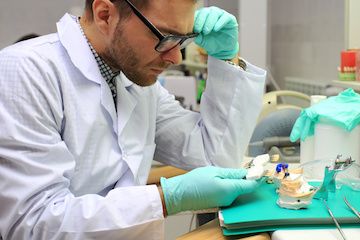How to Save Money on Dental Lab Costs
Approximately 10 percent of a dental practice's overhead is tied up in lab costs. Partnering with the right digital dental lab can be a boon or a bust when it comes to affecting that debt percentage. Gary Kaye, D.D.S., F.A.G.D., explains how building a strong business relationship with your dental lab will save you money in the long run.

Dental labs are more integrated in patient care than ever before. They're also a major component of a practice's overhead. That's why dentists need to prioritize their working relationships with labs.
Gary Kaye, D.D.S., F.A.G.D., founder of Kaye Dentistry PLLC, understands the value of partnering with the right dental lab. Kaye Dentistry is a world-class reconstructive, cosmetic and implant practice, so working with the right lab is critical to his success.
Not to mention that lab costs comprise between 8 and 10 percent of a practice’s overhead. With that amount of money on the line, you want to feel comfortable in your lab relationship.
“I think about two-thirds of dentists change labs within two years,” Kaye says. “And I think it may be related to changes in quality. So having a partnership with a lab where the quality has changed, or it’s not what the dentist expects, then you have somebody you’re able to communicate with. That’s a great partner.”
ABOUT RELATIONSHIPS
Kaye explains that in today’s digital world, open communication between the dentist and the lab is critical. Lab technicians can see the preparation of a tooth even before a prescription has been sent. So while there have always been partnerships with dental practices, the lab today is truly integrated into patient care.
And the beauty of building that relationship, Kaye explains, is you can try a lab first to see if it works for you.
“Most labs will give you that opportunity,” Kaye says. “That’s the beauty of selecting a lab. There are no long-term contracts with a lab. If you get a recommendation, you can try a lab, and see how it works.”
However, the concern within the dental profession is that when you try a new lab the first two cases may be done by a five-star technician, and the work is great. But as you move on over time and send in more cases, you might get assigned to their second- or third-rate technician.
“We know that all technicians like all dentists are not equal,” Kaye admits. “So that’s always a concern. The quality has to be continually monitored when you have a lab. The tenth crown or the hundredth crown should look as good as the first. And I think with digital we have more of a chance to attain that.”
But even as more work is performed digitally, relationships are built with people. As such, Kaye says it’s very important, whenever possible, to visit a lab, meet the people, and see who’s handling the work.
“These are really important things the lab is doing for us, making restorations that we put in our patients’ mouths that are going to stay there for years and years,” Kaye says. “And we want to make sure that (the work) is in line with the standards that we expect.”
EVALUATION TIME
Kaye says he evaluates a lab’s work every time he opens a restoration and examines it. He looks at function, at the quality and aesthetics, to determine if he has received a good prosthesis or not. Specifications include color, contour and position.
“Every dentist has preferences in terms of what they want from the lab,” Kaye says. “And the key is, are they listening to what we’re asking for? And if what we’re asking for is not reasonable, are we getting that communication back? So it’s all about communication and relationships.”
Does it make a difference whether you work with a large or small lab? Kaye says the challenge for many larger entities is maintaining quality, though that doesn’t mean it can’t be done. He compares it to Starbucks, where you receive pretty good service no matter where you go, but the local mom and pop coffee shop may be terrible. In other words, size alone is not the most important factor.
“At the end of the day, we’re all interested in that one, single transaction: What does the last restoration look like?” Kaye explains. “That’s really the essence of the lab relationship. And I don’t see that changing going forward because there’s still some art to the industry.”
The human factor can still make all the difference.
BOTTOM LINE
While lab costs represent on average 8 to 10 percent of a practice’s overhead, Kaye believes that when technology is well adopted and meshed with the human relationship factor, the debt percentage can be reduced. But the inverse is true as well.
“If (the impression is) not done well, you may actually increase your costs,” he says. “The remakes are very expensive, because we now have to bring the patient back. And we’re not getting paid for that extra appointment time.”
The other benefits of digital done well is shorter appointments, fewer remakes, and better longevity of the restorations,” Kaye says. “That can have a great impact on the bottom line of your practice because you’re able to generate more patients because people want to come to a practice that is doing things better: shorter appointments, and better-fitting crowns. So all of those things come into the cost equation.”